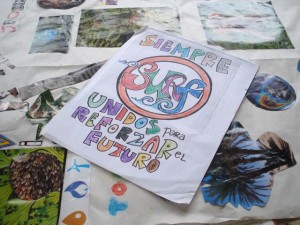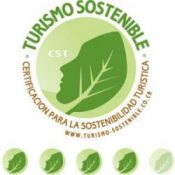Cruise with us!
The Bahia Aventuras I is a 2008 boat design complimented with a 2008 Suzuki 250HP that allows for comfort and style when navigating. It has 14 individual seats and accomadates any of our tours; a 4 person Private Sportfishing Tour to a 14-passenger Bahia Aventuras Combo Tour. The boat is great for whale watching, snorkeling trips to Cano Island, nature tours to Corcovado National Park, sport fishing, bird watching tours through the mangroves, dolphin encounters, and just cruising the beautiful Marino Ballena National Park in Uvita-Bahia Ballena, located in the south pacific near the osa peninsula of Costa Rica.
Frequently asked questions
Q. Is it guaranteed that I will see whales and dolphins?
A. Bahia Aventuras is located in the south pacific of Costa Rica near the Osa Peninsula. Our tours are focused in and around the Marino Ballena National Park, one of the most cetacean-rich areas in all of Costa Rica. Visitors have the opportunity to see a wide variety of different species from humpback whales to bottlenose dolphins as well as sea turtles, manta rays, sea birds and other marine life. We could never guarantee 100% that visitors will have encounters with whales and dolphins as they are not held in captivity. The beauty of the Marino Ballena National Park is that we do encounter whales and dolphins about 95% of our outings during the whale season which stretches from mid July and October, and again in December through March, as they migrate to and from feeding and mating grounds in the north and south hemisphere. We recommend that you plan two different tours and get your 10% discount with us to see the widest range of behaviors, species and opportunities for close encounters with the amazing marine life the area has to offer.
Q. What can I expect to see?
A. We can never offer 100% guarantee of encounters with wild animals. However the following list is to be used as a guide to what we commonly see throughout the year. This list is based on the areas past years of recorded sightings:
January: Spotted Dolphins, Humpback Whales, Bottlenose Dolphins, Spinner Dolphins, Common Dolphins, Pseudo Orcas, Pilot Whales
Occasional: Orcas, Brydes Whales, Rissos Dolphins
February: Spotted Dolphins, Humpback Whales, Bottlenose Dolphins, Spinner Dolphins, Common Dolphins, Pseudo Orcas, Pilot Whales
Occasional: Orcas, Brydes Whales, Rissos Dolphins
March: Spotted Dolphins, Humpback Whales, Bottlenose Dolphins, Spinner Dolphins, Common Dolphins, Pseudo Orcas, Pilot Whales, Beaked Whales
Occasional: Orcas, Brydes Whales, Rissos Dolphins
April: Spotted Dolphins, Bottlenose Dolphins, Spinner Dolphins, Common Dolphins, Pilot Whales
Occasional: Humpback Whales, Orcas, Brydes Whales, Rissos Dolphins, Pseudo Orcas
May: Spotted Dolphins, Bottlenose Dolphins, Spinner Dolphins
Occasional: Orcas, Brydes Whales, Rissos Dolphins, Pseudo Orcas, Common Dolphins, Pilot Whales
June: Spotted Dolphins, Bottlenose Dolphins, Spinner Dolphins
Occasional: Humpback Whales, Orcas, Brydes Whales, Rissos Dolphins, Pseudo Orcas, Pilot Whales,
July: Humpback Whales, Spotted Dolphins, Bottlenose Dolphins, Spinner Dolphins, Common Dolphins
Occasional: Orcas, Brydes Whales, Rissos Dolphins, Pseudo Orcas, Pilot Whales
August: Humpback Whales, Spotted Dolphins, Bottlenose Dolphins, Spinner Dolphins, Common Dolphins
Occasional: Orcas, Brydes Whales, Rissos Dolphins, Pseudo Orcas, Spinner Dolphins, Pilot Whales
September: Humpback Whales, Spotted Dolphins, Bottlenose Dolphins, Spinner Dolphins, Common Dolphins
Occasional: Orcas, Brydes Whales, Rissos Dolphins, Pseudo Orcas, Pilot Whales
October: Humpback Whales, Spotted Dolphins, Bottlenose Dolphins, Spinner Dolphins, Common Dolphin
Occasional: Orcas, Brydes Whales, Rissos Dolphins, Pseudo Orcas, Spinner Dolphins, Pilot Whales
November: Humpback Whales, Spotted Dolphins, Bottlenose Dolphins, Pseudo Orcas, Spinner Dolphins, Common Dolphins
Occasional: Orcas, Sei Whales, Brydes Whales, Rissos Dolphins, Pilot Whales
December: Humpback Whales, Spotted Dolphins, Bottlenose Dolphins, Pseudo Orcas, Spinner Dolphins, Common Dolphins, Pilot Whales
Occasional: Orcas, Brydes Whales, Rissos Dolphins
Q. Can I swim with whales and dolphins?
A. Swimming with whales and dolphins is illegal in Costa Rica. Also illegal is keeping whales and dolphins in captivity, not following legal practices for sightings and encounters and hunting. We encourage other companies to also follow best practices for marine tourism and not put too much stress and disruption on the whales and dolphins natural behaviors. By following best practices for marine tourism we can avoid causing constant disruption to their feeding, resting, nursing and other behaviors that might impact the health and well being of entire populations of whales and dolphins. Whale watching and dolphin encounters from our boats are powerful experiences that ignite a feeling of true awe! By viewing whales and dolphins in their natural habitat from our boat, you can start to explore their world while minimizing the disruption to their natural behaviors.
Q. When is the best time to come?
A. Anytime is a good time to come to Uvita-Bahia Ballena, Costa Rica and visit the Marino Ballena National Park. The “high tourist season-dry season” in Costa Rica is considered to be mid-November through April due to little or no rain. However, our tours continue year-round! Please remember that the whale season stretches from mid July through October, and again in December through March. As for the dolphins, they are always here! Many visitors enjoy coming during the “low season-rainy season” as there are less people and everything is green and blooming.
Q. What is the water and air temperature?
A. The water temperature is always between 82-85 degrees (perfect!) and air temperature stays in the low to mid 80’s.
Humpback Whale
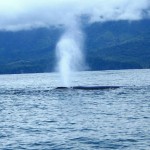 The humpback whale (Megaptera novaeangliae) is a Baleen whale. One of the larger rorqual species, adults range in length from 12-16 metres (40-50 ft) and weigh approximately 36,000 kilograms (79,000 lb). The humpback has a distinctive body shape, with unusually long pectoral fins and a knobbly head. It is an acrobatic animal, often breaching and slapping the water. Males produce a complex whale song, which lasts for 10 to 20 minutes and is repeated for hours at a time. The purpose of the song is not yet clear, although it appears to have a role in mating.
The humpback whale (Megaptera novaeangliae) is a Baleen whale. One of the larger rorqual species, adults range in length from 12-16 metres (40-50 ft) and weigh approximately 36,000 kilograms (79,000 lb). The humpback has a distinctive body shape, with unusually long pectoral fins and a knobbly head. It is an acrobatic animal, often breaching and slapping the water. Males produce a complex whale song, which lasts for 10 to 20 minutes and is repeated for hours at a time. The purpose of the song is not yet clear, although it appears to have a role in mating.
Found in oceans and seas around the world, humpback whales typically migrate up to 25,000 kilometers each year. Humpbacks migrate from the polar waters of South America between July and October and from the cold waters of North America to warmer tropical waters between the months of January and April. The whales come to the warm and quiet waters surrounding the Marino Ballena National Park, Caño Island, and Osa Peninsula area to give birth to their young.
Like other large whales, the humpback was and is a target for the whaling industry. Due to over-hunting, its population fell by an estimated 90% before a whaling moratorium was introduced in 1966. Stocks of the species have since partially recovered; however, entanglement in fishing gear, collisions with ships, and noise pollution also remain concerns. It is believed they number about 30,000-40,000 at present, or about 30-35% of the original population.
Physical description of the humpback whale
The head of a humpback whale is broad and rounded when viewed from above, but slim in profile. The body is quite round, narrowing to a slender peduncle (tail stock). The top of the head and lower jaw have rounded, bump-like knobs, each containing at least one stiff hair. The purpose of these hairs is not known. There are between 20-50 ventral grooves which extend slightly beyond the navel.
Colors of the humpback whale
The body is black on the dorsal (upper) side, and black and white on the ventral (under) side. This color pattern extends to the flukes. When the humpback whale “sounds” (goes into a long or deep dive) it usually throws its flukes upward, exposing the black and white patterned underside. This pattern is distinctive to each whale. The flippers range from all white to all black dorsally, but are usually white ventrally.
Fins and flukes, length and weight of the humpback whale
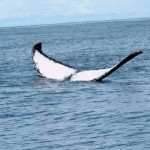 About 2/3 of the way back on the body is an irregularly shaped dorsal (top) fin. Its flippers are very long, between 1/4 and 1/3 the length of its body, and have large knobs on the leading edge. The flukes (tail), which can be 18 feet (5.5 m) wide, is serrated and pointed at the tips. Adult males measure 40-48 feet (12.2-14.6 m), adult females measure 45-50 feet (13.7-15.2 m). They weigh 25 to 40 tons (22,680-36,287 kg).
About 2/3 of the way back on the body is an irregularly shaped dorsal (top) fin. Its flippers are very long, between 1/4 and 1/3 the length of its body, and have large knobs on the leading edge. The flukes (tail), which can be 18 feet (5.5 m) wide, is serrated and pointed at the tips. Adult males measure 40-48 feet (12.2-14.6 m), adult females measure 45-50 feet (13.7-15.2 m). They weigh 25 to 40 tons (22,680-36,287 kg).
Feeding habits of the humpback whale
Humpback whales feed on krill, small shrimp-like crustaceans, and various kinds of small fish. Each whale eats up to 1 and 1/2 tons (1,361 kg) of food a day. As a baleen whale, it has a series of 270-400 fringed overlapping plates hanging from each side of the upper jaw, where teeth might otherwise be located. These plates consist of a fingernail-like material called keratin that frays out into fine hairs on the ends inside the mouth near the tongue. The plates are black and measure about 30 inches (76 cm) in length. During feeding, large volumes of water and food can be taken into the mouth because the pleated grooves in the throat expand. As the mouth closes water is expelled through the baleen plates, which trap the food on the inside near the tongue to be swallowed.
Humpback whales mating and breeding
Humpback whales reach sexual maturity at 6-10 years of age or when males reach the length of 35 feet (11.6 m) and females reach 40 feet (12 m). Each female typically bears a calf every 2-3 years and the gestation period is 12 months. A humpback whale calf is between 10-15 feet (3-4.5 m) long at birth, and weighs up to 1 ton (907 kg). It nurses frequently on the mother’s rich milk, which has a 45% to 60% fat content. The calf is weaned to solid food when it is about a year old.
Distribution and migration of humpback whales
Found in all the world’s oceans, most populations of humpback whales follow a regular migration route, summering in temperate and polar waters for feeding, and wintering in tropical waters for mating and calving. In the Arabian Sea, a year-round non-migratory population of humpbacks appears not to follow this general rule.
Natural history of the humpback whale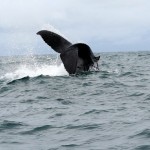
At least 3 different species of barnacles are commonly found on both the flippers and the body of the humpback whale. It is also home for a species of whale lice, Cyamus bops. Humpback whales are active, acrobatic whales. They can throw themselves completely out of the water (breaching), and swim on their backs with both flippers in the air. They also engage in “tail lobbing” (raising their huge flukes out of the water and then slapping it on the surface) and “flipper slapping” (using their flippers to slap the water). It is possible that these behaviors are important in communication between humpbacks.
Perhaps the most interesting behavior of humpback whales is their “singing.” Scientists have discovered that humpback whales sing long, complex “songs”. Whales in the North American Atlantic population sing the same song, and all the whales in the North American Pacific population sing the same song. However, the songs of each of these populations and of those in other areas of the world are uniquely different. A typical song lasts from 10-20 minutes, is repeated continuously for hours at a time, and changes gradually from year to year. Singing whales are males, and the songs may be a part of mating behavior.
Status of the humpback whale
Because their feeding, mating, and calving grounds are close to shore and because they are slow swimmers, the humpback whales were an easy target for early whalers. The International Whaling Commission (IWC) gave them worldwide protection status in 1966, but there were large illegal kills by the Soviets until the 1970’s. It is believed they number about 30,000-40,000 at present, or about 30-35% of the original population.
*Adapted from American Cetacean Society for educational purposes.
Costa Ricas Marine Resources
Costa Rica’s marine area reaches 580,000 km2, approximately 10 times larger than its land area of only 52,100 km2. The Costa Rican ocean generates countless biological, economical and social benefits and in its resources lays the future of the country. The Marino Ballena National Park and the surrounding areas of Cano Island Biological Reserve and front bays of the entire Osa Peninsula are beautiful marine areas where locals and visitors alike can experience whales, dolphins, sea turtles, marine birds, colorful fish and amazing coral reefs.
WHALES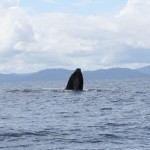
Whales are large, magnificent, intelligent, aquatic mammals. They breathe air through blowholes into lungs (unlike fish who breathe using gills). Whales have sleek, streamlined bodies that move easily through the water. They are the only mammals, other than manatees (seacows), that live their entire lives in the water, and the only mammals that have adapted to life in the open oceans.
Scientists believe that early whales actually walked the earth. The theory, supported by recent fossil finds in the foothills of the Himalayas, is that about 53.5 million years ago, whales were amphibious. They originated as land mammals, and gradually ventured into the water in search of food. They fed on fresh and saltwater fish. Eventually, they lost their legs and nostrils, and became the creatures we know today.
The Humpback Whale, Pilot Whale, Bryde’s, and False Orca are just some of the whales that visit the Marino Ballena National Park and the surrounding areas of Cano Island Biological Reserve and front bays of the entire Osa Peninsula.
DOLPHINS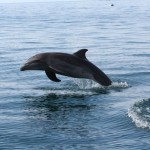
Dolphins are marine mammals that are closely related to whales and porpoises. There are almost forty species of dolphin in seventeen genera. They vary in size from 1.2 metres (4 ft) and 40 kilograms (88 lb), up to 9.5 m (30 ft) and ten tonnes. They are found worldwide, mostly in the shallower seas of the continental shelves, and are carnivores, mostly eating fish and squid. The family Delphinidae is the largest in the Cetaceans, and relatively recent: dolphins evolved about ten million years ago, during the Miocene. Dolphins are considered to be amongst the most intelligent of animals and their often-friendly appearance and seemingly playful attitude have made them popular in human culture.
The Bottlenose Dolphin, Pan-Tropical Spotted Dolphin, Common Dolphin and Spinner Dolphin are permanent residents and can be generally observed year round breeding and feeding in the warm tropical waters of the Marino Ballena National Park, Cano Island Biological Reserve and Osa Peninsula.
SEA TURTLES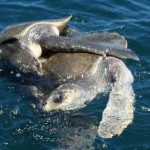
Sea turtles are large, air-breathing reptiles that inhabit tropical and subtropical seas throughout the world. Their shells consist of an upper part (carapace) and a lower section (plastron). Hard scales (or scutes) cover all but the leatherback, and the number and arrangement of these scutes can be used to determine the species. Sea turtles come in many different sizes, shapes and colors and the most common sea turtles in the South Pacific, Osa Peninsula of Costa Rica are the Green Sea turtles, Hawksbill turtles and Olive Ridley turtles.
Summer Student Travel Groups
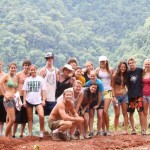 Bahia Aventuras has started organizing plans to host several student travel groups for the summer of 2010 in Uvita-Bahia Ballena. Community service, whale watching, snorkeling, surf lessons, and cultural exchanges are some of the highlights of the 2010 summer programming. For the third year in a row Bahia Aventuras will play host to Rustic Pathways Surf and Service program. The program has a focus on learning how to surf, community service, and participating in cultural exchanges with local community members and youth. Included in the program is the famous Cano Island Snorkel Tour with Bahia Aventuras where students get to learn about the Marino Ballena National Park, participate in whale watching, dolphin encounters, and snorkel beautiful reefs in one of Costa Rica’s best island tours! When the students aren’t busy taking surf lessons, snorkeling, whale watching or enjoying a beautiful sunset they
Bahia Aventuras has started organizing plans to host several student travel groups for the summer of 2010 in Uvita-Bahia Ballena. Community service, whale watching, snorkeling, surf lessons, and cultural exchanges are some of the highlights of the 2010 summer programming. For the third year in a row Bahia Aventuras will play host to Rustic Pathways Surf and Service program. The program has a focus on learning how to surf, community service, and participating in cultural exchanges with local community members and youth. Included in the program is the famous Cano Island Snorkel Tour with Bahia Aventuras where students get to learn about the Marino Ballena National Park, participate in whale watching, dolphin encounters, and snorkel beautiful reefs in one of Costa Rica’s best island tours! When the students aren’t busy taking surf lessons, snorkeling, whale watching or enjoying a beautiful sunset they will work closely with community members on small-scale construction, environmental, and social projects that will contribute to community’s economic development. By working alongside community members the students will immerse in the flow of life in the friendly beach town of Uvita-Bahia Ballena and learn about the culture of PURA VIDA! Radical sunsets, beaches lined with palm trees, crystal clear blue water, and friendly locals all contribute to a great week for the students in Uvita-Bahia Ballena.
will work closely with community members on small-scale construction, environmental, and social projects that will contribute to community’s economic development. By working alongside community members the students will immerse in the flow of life in the friendly beach town of Uvita-Bahia Ballena and learn about the culture of PURA VIDA! Radical sunsets, beaches lined with palm trees, crystal clear blue water, and friendly locals all contribute to a great week for the students in Uvita-Bahia Ballena.
Reflect on the great beauty of the Marino Ballena National Park
Bahia Aventuras and Thinking Beyond Borders – Bringing different cultures together
In September 2009 Bahia Aventuras teamed with Thinking Beyond Borders for the second year in a row to help facilitate the best gap year program in the world! Thinking Beyond Borders gap year program is designed for students to explore international development through global service learning and academic study. The organization has the mission:
- To empower youth as agents of proactive change by developing consciousness of global issues.
- To translate learning into action.
The Ideal start to a Gap Year Program
Thinking Beyond Borders program orientation in Uvita – Bahia Ballena, Osa, Costa Rica is an opportunity to prepare for eight months of service learning and traveling throughout South America, Africa, Asia and the USA. During the orientation students begin exploring the curriculum by learning about various development issues and why they are immediate problems in each country. They also learn how to travel in a culturally sensitive manner, how to communicate with people when you don’t speak the same language, and how to immerse yourself into a new community. Finishing out the orientation, students learn the safety protocol, including how to prevent minor illness, general traveling “do’s and don’ts, and good conduct to keep yourself healthy and safe. The orientation program challenges students to develop new perspectives on themselves and the world. Set goals to reach new levels of personal and global consciousness. Identify strengths and pinpoint areas to improve. Engage in team building and leadership activities that unite this incredible and talented group of individuals.
Bahia Aventuras and Thinking Beyond Borders
Together with Bahia Aventuras Team Members and local community leaders, the Thinking Beyond Borders students attend workshops about local community economic development. Connect with nature and create powerful experiences while participating in whale watching, snorkeling, and dolphin encounter boat tours in the Marino Ballena National Park. Learn yoga and surfing while living for 10 days where the rainforest and the ocean come together. They hike through primary and secondary rainforest, swim under waterfalls, play beach soccer and reflect on the journey to come while watching the sunset over the famous Punta Uvita Whale Tail.
Check out the album of Thinking Beyond Borders 2009-10 student photos from the 11 day orientation in Costa Rica!
Responsible Marine Tourism Practices
Bahia Aventuras, the KETO Foundation, and the Association of Marine Tour Operators of the Marino Ballena National Park, in Uvita – Bahia Ballena have been working together over the last few months in the development of Responsible Marine Tourism Practices. Through many meetings, discussions, and trainings, drafts of the standards were developed, reviewed, and revised in a consensus-building process. Development of the standards for Planning of Boat Tours, Boat Maintenance, Training of Boat Captains and Guides, Community Responsibility, Navigation, Whale watching, Snorkeling and Scuba Diving, is only the beginning. Next, is the implementation phase and then field-testing. Many local companies are still in the process of adopting the standards and will work together with the KETO Foundaton and the Association of Marine Tour Operators of the Marino Ballena National Park to evaluate their overall effectiveness, attainability, and affordability.
Leading the way in accomplishing the standards is Team Bahia Aventuras. Establishing a plan for each category, Bahia Aventuras will be implementing the rigorous standards in 2010 to achieve the most Responsible Operation of Marine Tourism possible, and continue providing visitors the best and most sustainable boat and nature tours in Uvita – Bahia Ballena, Osa, Costa Rica.
